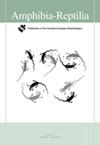COI条形码提供了可靠的物种识别,并精确定位了西北极两栖动物的神秘多样性
IF 1.3
4区 生物学
Q3 ZOOLOGY
引用次数: 1
摘要
为各种分类群组装DNA条形码参考库使研究人员能够使用代谢编码或环境DNA方法来快速了解特定环境中的多样性。然而,我们使用参考文库的能力取决于DNA条形码恢复分类边界和识别物种的准确程度,而这一点很少被考虑。我们为西北极的两栖动物构建了一个广泛的COI条形码库,并成功地从60个无尾目和73个无尾目的物种中回收了条形码(分别占西北极名义无尾目物种的94%和98%),涵盖了该地区大多数物种的种内多样性。我们使用条形码缺口、效率分析和两种系统发育物种划界方法测试了我们组装的DNA条形码数据集用于物种识别的有效性。我们获得了1251个标本(691个无尾和560个无尾)的DNA条形码,物种鉴定的成功率很高(92-96%)。许多样本中没有条形码缺口与物种错误识别有关,这表明物种形成初期或隐蔽多样性,或先前描述的线粒体渗入事件。系统发育物种的划分方法导致了目前公认的分类学的大量超支。这个COI条形码库为西北极两栖动物提供了一个几乎完整可靠的参考库。我们强调了生成全面和精心策划的参考文库的重要性,其中包括种内和种间遗传变异性,以及当存在模糊或不正确的DNA条形码时需要进行详细的分类修订。本文章由计算机程序翻译,如有差异,请以英文原文为准。
COI barcoding provides reliable species identification and pinpoints cryptic diversity in Western Palearctic amphibians
Assembling DNA barcode reference libraries for various taxonomic groups allows researchers to use metabarcoding or environmental DNA approaches to gain a rapid understanding of diversity in given environments. However, our ability to use reference libraries depends on how accurately DNA barcodes are able to recover taxonomic boundaries and identify species, which is rarely considered. We constructed an extensive COI barcoding library for amphibians of the Western Palearctic and successfully recovered barcodes from 60 urodele and 73 anuran species (representing 94% and 98% of the nominal anuran and urodele species in the Western Palearctic, respectively), covering the intraspecific diversity of the majority of species in this region. We tested the effectiveness of our assembled DNA barcode dataset for species identification using barcoding gap, efficiency analyses, and two phylogenetic species delimitation methods. We obtained DNA barcodes for 1251 specimens (691 anurans and 560 urodeles) with a high success rate (92-96%) of species identification. The absence of a barcoding gap in a number of samples was linked to species misidentifications, which suggest incipient speciation or cryptic diversity, or previously described mitochondrial introgression events. The phylogenetic species delimitation methods resulted in substantial oversplitting of currently accepted taxonomy. This COI barcoding library provides an almost complete and reliable reference library for Western Palearctic amphibians. We highlight the importance of generating comprehensive and well curated reference libraries that include intra- and interspecific genetic variability and the need of detailed taxonomic revision when ambiguous or incorrect DNA barcodes exist.
求助全文
通过发布文献求助,成功后即可免费获取论文全文。
去求助
来源期刊

Amphibia-Reptilia
生物-动物学
CiteScore
3.10
自引率
6.20%
发文量
39
审稿时长
6-12 weeks
期刊介绍:
Amphibia-Reptilia is a leading European multi-disciplinary journal devoted to most of the aspects of herpetology: ecology, behaviour, evolution, conservation, physiology, morphology, paleontology, genetics, and systematics.
Amphibia-Reptilia publishes high quality original papers, short-notes, reviews, book reviews and news of the Societas Europaea Herpetologica (SEH). The Societas Europaea Herpteologica (SEH) website is located at: www.seh-herpetology.org.
 求助内容:
求助内容: 应助结果提醒方式:
应助结果提醒方式:


